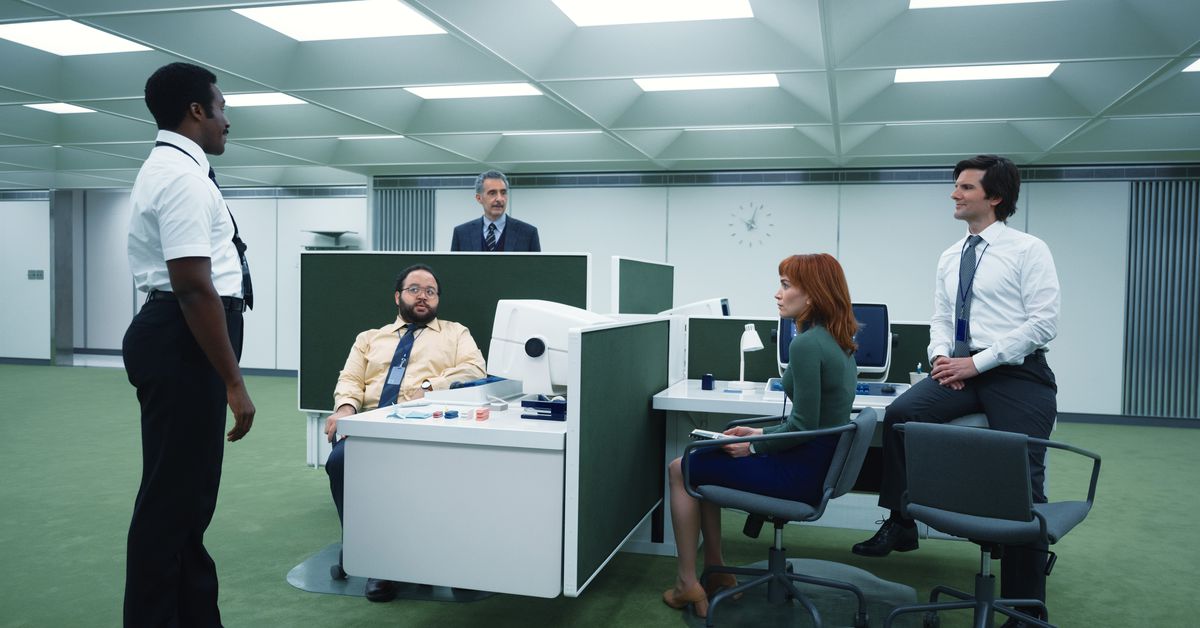The weird computers and claustrophobic hallways of Severance
In the vast underground office of Lumon, the megacorporation at the heart of Apple TV Plus’ thriller Severance, the computers are downright bizarre. At first they look a bit like an old Mac, but the closer you look, the more strange they become. The CRT display is somehow a touchscreen. The beautiful blue keyboard is saddled with a gigantic trackball. The goal, production designer Jeremy Hindle tells The Verge, was to design a device that doesn’t make a lot of sense, mirroring the purgatory-like world that exists only within Lumon’s basement. “The idea was that anything you could see underground doesn’t exist up top anywhere,” says Hindle. “You’ll never see that computer or that keyboard.”
This article contains light spoilers for Severance.
Severance takes place in a world where a new procedure — the titular severance — allows workers to split their lives in two after a little brain surgery. They essentially become two people: one who lives a relatively normal life and another whose entire existence resides in a purgatory-like office. Because of this, the design of the office itself was extremely important. It needed to feel like a place outside of time and space. “You have to make sure that the inside and outside world are [different] enough that you’re immersed in the world, so you feel like you’re severed when you’re down there with them,” explains Hindle.
The starting point was offices from the 1960s. “They’re working in this office environment, and they’re brought in to just be these pro-workers, and they’re birthed into the place,” Hindle says. “It should be like what offices used to be like. Beautiful desks, beautiful structures, beautiful lights. Just about work. On the desk there’s one pen, a rolodex, a phone. It felt like it had to be that same tone — but way more playful.”
Image: Apple
At first glance, the offices in Severance look fairly normal. They’re brightly lit with clean white walls and carpeted green floors. But in the macrodata refinement wing — where much of the show takes place — things are a little off. Despite having a huge room, the four workers are crammed together via a cluster of desks in the middle of the space. From there, things get even stranger. The hallways, designed with the intention of making people lost, twist and turn in confusing ways, and there are rooms filled with 3D printers and baby goats.
The breakroom, despite its name, is a bleak, dark place where employees are punished for breaking the rules. In order to access it, they’re forced down a long, narrow, and dimly lit hallway that’s barely wide enough for a single person. “The space is what makes people feel uncomfortable when they watch it,” says Hindle. “In [macrodata refinement] the ceiling is so low, so even though the room is a football field, it’s claustrophobic in a strange way.” (According to Hindle, series creator Dan Erickson once drew him a map of the labyrinth basement, which he describes as a “maze.”)
The next step was perfecting the smaller details because the underground office is meant to be its own little world. “It’s not a spaceship, but it is a spaceship,” Hindle says, citing the original Alien as a big source of inspiration. That meant that everything in it, from the desks with their adjustable dividers and the snacks in the vending machine to the finger traps given out as bonuses had to be created in-house. Hindle estimates that the production team designed around 100 different products to be used in the office, all meant to evoke the Lumon aesthetic.
:no_upscale()/cdn.vox-cdn.com/uploads/chorus_asset/file/23371793/ATV_Severance_Photo_010110.jpg)
Image: Apple
Which takes us back to the computers. Those Lumon rigs, which employees use to find “scary” numbers in a Minesweeper-like program, look like they were hacked together from several other machines. “The trackball just cracked me up,” Hindle says. “We kept thinking, ‘If you’re experimenting with these people, what would you put in front of them?’” Not only were they designed to look out of time, but also to give the cast of office drones — which includes the likes of Adam Scott, Britt Lower, Zach Cherry, and a very charming John Turturro — something to play around with while acting. “Imagine how fun it would be to sit at this thing, as opposed to if I put a laptop in front of them,” Hindle says. “It’s like a child’s device.”
Hindle says that the computers are functional and that the actors are really messing with numbers on screen during the show. The machines also went through multiple revisions before production began to get the size just right (among other things), so that they were large enough to be a focal point but small enough to not obscure the actors or interfere with their eyelines. As Hindle notes, “They’re in this room for three hours in the first season. It had to be pretty special and pretty fun.”
When you combine all of these elements — the retrofuturistic computers, the labyrinth layout, the ‘60s decor, the claustrophobic hallways — and add in voyeuristic cinematography that’s often reminiscent of security camera footage, you end up with a show that’s both instantly familiar and uncomfortably strange. In these offices, even a dance party takes on a tinge of horror, which, given one of Hindle’s main inspirations, shouldn’t be too surprising.
“It really was my Twin Peaks,” he explains. “The similarity is that they have a tone to the writing, the art direction, the design, the cinematography. It is its own world.”
For all the latest Technology News Click Here
For the latest news and updates, follow us on Google News.

